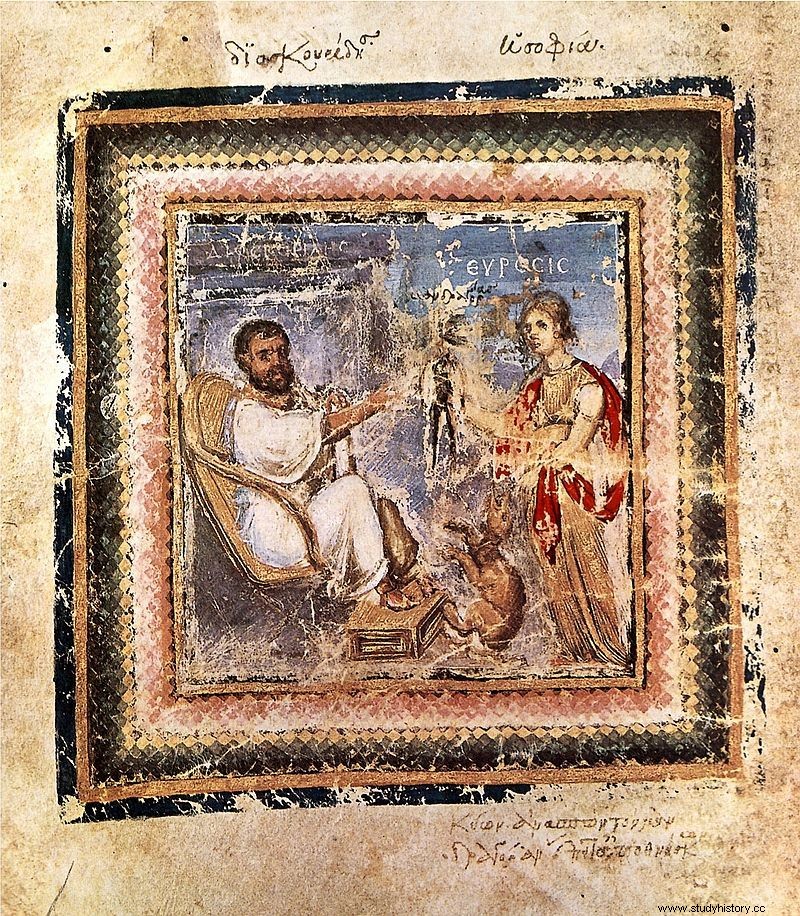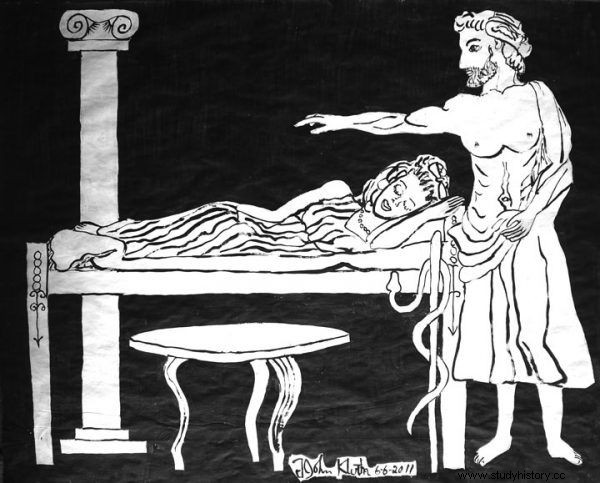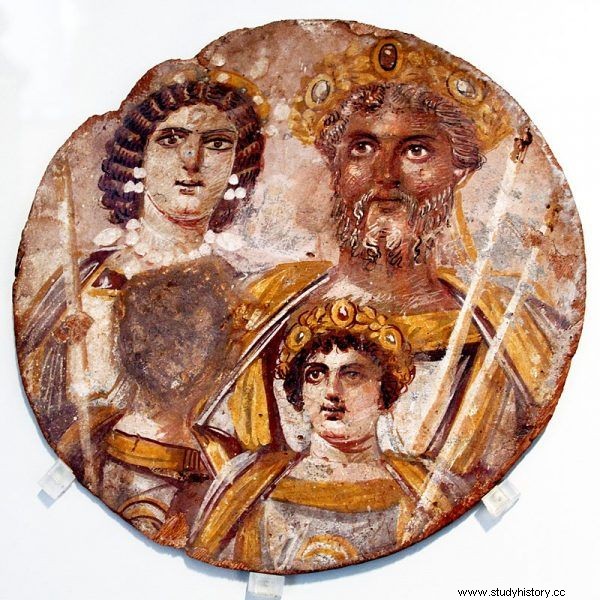Vegetable preparations, pre-condoms from sheep intestines, piercing of limbs, clasps for genitals, and finally ear incisions. Already the ancients struggled with the problem of unwanted pregnancy. Were they able to find the most effective contraceptive?
Two thousand years ago, Areteus of Cappadocia argued that a man who protects his seed is healthier and braver, like an athlete before a performance. Women, apart from priestesses condemned to a virgin life in the temples, were treated as machines for giving birth to children. In antiquity, abstinence was the main priority in preventing pregnancy.
However, there have been occasional cases of clitoridectomy, circumcision of women to prevent their alleged excessive vigor. Some doctors supported the willpower of those interested by using the so-called infibulation - in men a penis was pierced and a clamp with a small buckle was placed on it, in women a similar procedure was performed with the genitals . Well, anal braces were also used!
Special covers made of leather and horsehair were also invented. Latin poet Marcjalis, who lived at the turn of the 1st and 2nd centuries CE, mentioned in a poem about a lady with such a veil and advised her mockingly that she should also wear a similar face. In another epigram, he wrote about a bath with an infibulated slave. Most often, servants, slaves were “secured” in this way, but not only.

We associate circumcision today mainly with a religious act found in Judaism. However, genital mutilation was also carried out by the ancient Greeks and Romans, considering it one of the means of contraception.
It is not surprising if in this situation someone found abstinence bizarre. And what were the other, less drastic methods of preventing unwanted pregnancy? The ancients were aware of the existence of the menstrual cycle in women, which is why the Greek physician and philosopher Soranus of Ephesus advised them to have intercourse on "safe" infertile days.
Another method he recommended was intermittent intercourse. Women were also suggested to sneeze and squat after intercourse with their partner to expel their sperm . But perhaps you might as well trust magic amulets, the strength of a peony bouquet placed under your bed or carrying worms from a hairy spider's head - which was also recommended by some experts ...
Ferula and wild carrot
If these methods were truly effective and practical, nothing else would have been invented. Meanwhile, we know from treatises written by Greek and Roman doctors that appropriate herbal preparations were effective in preventing pregnancy. Women used decoctions of rue, white willow and field mint. They trusted in the power of pomegranate potions (after all, this is how the mythical Persephone, kidnapped by Hades, protected herself against pregnancy!). The crushed juniper berries placed next to the vagina were also supposed to be effective. The ferula - celery-dill plant, which prevents pregnancy in smaller doses, and has an early abortion effect in larger doses, has gained popularity.
In turn, wild carrot seeds were treated as a kind of "morning after pill". On the latter example, we can also consider whether it was just rubbish, or whether at least some ancient means could actually be effective. Here is a medical historian, prof. John M. Riddle, pointed out that wild carrots are still used in China, India and ... in the North Carolina mountains in the USA. Its effects have been proven by laboratory tests:certain organic compounds (terpenoids to be exact) contained in the seeds of this plant may hinder the possibility of embryo implantation. They also inhibit the production of progesterone after conception.

Dioscorides was a Greek physician and botanist who lived and worked in Rome during the time of Nero. He created a 5-volume work, which is the most important book on herbs in ancient times (one of the pages of the work is shown in the illustration).
However, the most famous plant remedy was silphium , described by Dioscorides, a Greek physician working in Rome, during the time of Nero in the 1st century CE. It was an African bush with yellow flowers and a long stem. As indicated by Dr. Krystyna Stebnicka from the Institute of History, University of Warsaw, is characterized by an ancient coin from Cyrenaica (Libya), which “leaves no doubt that this plant was supposed to protect women from an unwanted child. On the obverse of the coin you can see a trunk with flowers, and on the reverse, it is sitting by silphium the woman with her hand pointing towards the womb. ”
The problem is silphium it has become a victim of its own popularity. Its resources were so depleted that the plant became extinct. Already in the epoch of Julius Caesar, this ruler hid its several hundred kilograms in the state treasury as an extremely valuable deposit. Later, the plant became rare. During the reign of Emperor Nero, it was already considered a curiosity. Today it is difficult to say what its supposedly phenomenal effectiveness consisted of. The miraculous drug survives only in ancient pictures.
Today, researchers are wondering what plant it could have been (many believe that it was a type of fennel and associate it with the aforementioned ferula). And they argue whether it was its seeds with - as seen on ancient coins - the characteristic heart-shaped shape that could have become a timeless sign of love. It would be an unusual story chuckle if our "romantic" symbol turned out to reflect de facto the shape of the ancient contraceptive pill .
Not only herbs
Some Greek and Roman women opted for more aggressive preparations. Hippocrates assured that a woman would not get pregnant for a year after drinking the so-called bowl - a contraceptive with copper sulphate . I wonder how long she would live with the regular use of this miracle drug ... The lead white ointment applied vaginally also helped - but today we know that its use could have been lethal for the fair sex.
Fortunately, the mazidło had competition. Ancient doctors told that in order to prevent pregnancy, a woman should apply a sticky substance inside before intercourse:for example, cold olive oil mixed with vinegar, honey, cedar gum, gum resin with wine, balsam tree juice, moist alum ...
Particularly acidic substances, due to their reaction, could actually have a spermicidal effect. Other measures were to prevent sperm from entering the uterus; pull off, cool and close the vagina. For this purpose, vaginal rings (made of wool soaked in, for example, pine bark and sumac grated with wine) were applied and had to be removed a few hours after intercourse.

The ancients tried in various ways to prevent unwanted pregnancies. Once fertilized, however, they did not hesitate to induce miscarriages and perform abortions. The picture shows a painting of Asclepius, the mythological god of medicine.
When neither this nor any other plugs, globules or suppositories helped, and an unwanted pregnancy had already occurred, ancient medics suggested that the women lead to a miscarriage . Either with the help of special plant extracts, or by irritating the uterus with papyrus strips inserted inside, or by overloading the woman's body - excessive exercise, carrying heavy loads, shaking in the carriage, spicy foods, hot baths or intense massages. As a last resort, it was decided to have a mechanical abortion.
Abortion controversy
The ancients did not regard abortion as ethically reprehensible. Although fetal spending was criticized by the founders of the most important city-states - in Sparta Lycurg (9th-8th centuries BCE) and Solon in Athens (7th-6th centuries BCE) - but they tolerated it at the same time. On the other hand, the sage Plato even recommended that in certain cases "not a single fruit of such an intercourse would see the light of day if it were to flood."
Aristotle also considered abortion acceptable - but only until the child begins to move. The Greeks considered the termination of pregnancy in the event of the father's death unacceptable. Only the Macedonian king Philip V (Hannibal's ally in the fight against Rome), concerned about the depopulation of his country, issued a law limiting not only abortion, but also contraception and the practice of abandoning children . As a result, the number of men under arms in Macedonia has increased by half in thirty years.
In turn, according to Roman tradition, the legendary Romulus issued a law prohibiting termination of pregnancy and allowing the husband to abandon his spouse if, against his will, she used poisonous preparations to get rid of the fetus. However, in practice, no one fought with abortion seriously, and they issued the first special decrees against those guilty of abortion only in the 3rd century CE. Emperors of the Severus dynasty:Septimius and Caracalla.

Caracalla was one of the Roman emperors who issued a special decree against abortion. In the illustration, a fragment of a fresco depicting Julia Domna, Septimius Severus and Caracalla.
It's just that it was still not the child's life that was at stake, but the violation of the father's right to offspring. And these imperial regulations were forgotten. Even when the Roman empire was dominated by the Christian religion, it did not change much, because there were still no clear anti-election laws. Surprisingly, such prescriptions were found in inscriptions in some pagan temples . In the 4th century CE it is recorded in Cyrene that those guilty of abortion are unclean and may not enter the temple complex for some time. In turn, visitors to the Dionysus sanctuary in Philadelphia, Lida were strictly forbidden to distribute and use any abortion and abortion agents.

This article was written during the author's work on the book "Ages of shamelessness. Sex and erotica in antiquity ”(CiekawostkiHistoryczne.pl 2018).
What was the procedure like in ancient times, which still arouses fierce discussions among supporters of the pro-life option and pro-choice ? Dr hab. Krystyna Stebnicka from the University of Warsaw reports:
Tertullian, a second-century Christian writer in Africa, condemning abortion, writes that it was performed using a bronze probe. This instrument was used to pierce the amniotic membrane of the fetus, but the tools available to any ancient gynecologist might as well. The basic instrument in his instrumentation was a metal dilator for the dilation of the cervix (...). In contrast, various forms of curved knives were used to remove a dead fetus from a woman's body . Termination of pregnancy was performed not only by doctors, but also by midwives .
Doctors could refuse to have an abortion if the child was the fruit of adultery, or if the future mother wanted him out of concern for preserving her beauty. In accordance with the words of the Hippocratic Oath, doctors only undertook not to administer a pessary to women. (intrauterine puck used to induce a miscarriage) - there was no question of other methods.
Cure behind the ear
The sterilization procedures for women - probably involving the removal of ovaries - which were brought to Rome by experts from Asia Minor, also seemed to be no less drastic. In the case of men, it was possible to castrate; the removal of the testicles did not mean the end of sexual life. But instead of mutilating yourself like that, it was probably easier and safer to educate yourself - or to stick with anal and oral intercourse, if only the couple satisfied.
And since we've already touched on men ... Most of the methods described above, apart from infibulation, meant trouble or even a danger only for women. But what about their partners? Could they not have ensured that an unwanted pregnancy would not occur?
Yes. They used condoms - following the example of the Egyptians and the mythical king of Crete Minos, who had to protect their partners from scorpions and snakes coming out of his penis (was it a metaphorical representation of a sexually transmitted disease?). These pre-condoms were made from sheep intestines or bladders. Unfortunately, they were much less practical and more unreliable than modern ones.

Contraception in antiquity applied to both sexes. Men not only used prototypes of modern condoms, but also underwent "sterilization" treatments. Painting by Louis-Jean Francois Lagrenee "Mars and Venus".
In antiquity, a rather specific method of sterilizing men was created, which consisted in making ... incisions around the ears. This was due to the belief of some philosophers, especially the Pythagoreans, that a seed is a "brain drop." If so, it had to flow to the penis from the head, along the ears. So it is logical, as Hippocrates pointed out, that when this path is cut properly, a scar will prevent the seed from reaching the lower parts of the body.
If this would be so easy! Either way, the men - and the cultures of ancient Greece and Rome mostly revolved around them - apparently had problems other than contraception on their minds.
***
The text was created during the author's work on his latest book. " Ages of shame. Sex and erotica in antiquity ” .
